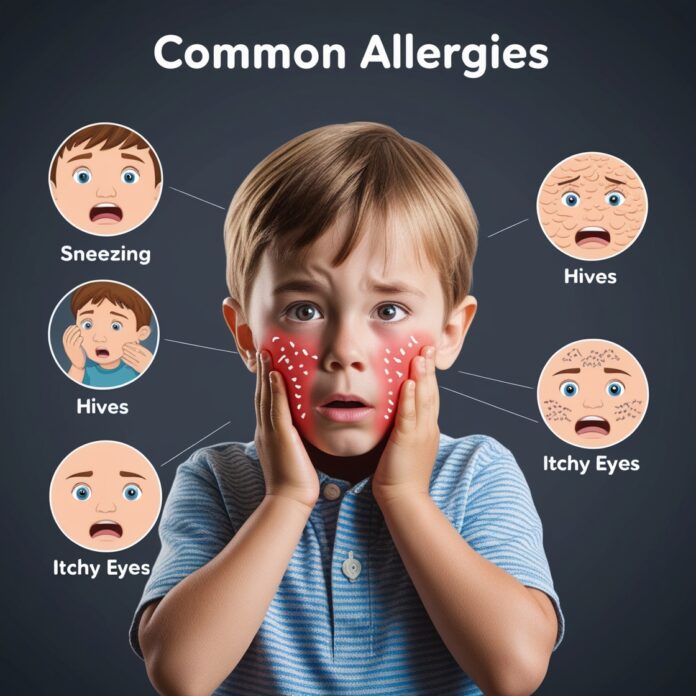Childhood allergies are on the rise and may significantly affect your child’s life. Being aware of common childhood allergies, signs accompanying them, and ways of effective prevention and treatment is crucial for every parent. Here, we review the five most widespread childhood allergies and provide you with practical recommendations on how to cope with each of them.
1. Food Allergies
Food Allergy Symptoms
Food allergies are one of the prevalent forms of allergies among children, which are usually critical in severity. The symptoms may include:
- Hives or rashes on the body
- Swollen parts of the body, especially the face and lips
- Aching stomach, vomiting, or loose motion
- Wheezing or trouble in breathing
Common Allergens
The most common food allergens for children include peanuts, tree nuts, eggs, milk, soy, wheat, fish, and shellfish.
Prevention and Treatment
- Prevention: Introduce new foods into your child’s diet in moderation and watch for any possible reactions. High-risk foods such as nuts should be discussed with your pediatrician regarding an appropriate time of introduction.
- Treatment: If the reaction is not serious, antihistamines are usually effective. If it is a severe reaction, treatment may need to involve an injection of epinephrine with an EpiPen.
2. Seasonal Allergies
Symptoms of Seasonal Allergies
Also known as hay fever or allergic rhinitis, seasonal allergies often arise from pollen and other environmental aggravants. Symptoms of allergic rhinitis include:
- Sneezing and runny nose
- Watery or itchy eyes
- Nasal stuffiness
- Coughing or sore throat
Prevention and Treatment
- Prevention: Avoid having the windows open during peak seasons of pollen. Bathe your child after playing outdoors to remove the captured allergens on skin and hair.
- Treatment: The symptoms can be soothed with the use of antihistamines and nasal sprays. Immunotherapy like allergy shots is helpful for long-term management.
3. Allergies to Pets
Symptoms of Allergies to Pets
Pet allergies rank among the most common allergies in children. It mainly emanates from cats and dogs. Symptoms include:
- Sneezing and nose itch
- Watery or red eyes
- Skin rashes or hives
- Coughing or wheezing
Prevention and Treatment
- Prevention: Bath and groom your pets regularly besides keeping them out of your child’s bedroom to reduce exposure.
- Treatment: Symptoms can be relieved through the use of antihistamines and decongestants. For those displaying acute symptoms, it is best to keep pets outdoors or restrict their entry into the house.
4. Dust Mite Allergies
Symptoms of Dust Mite Allergies
Dust mites are minute insects which reside in dust and can cause allergies. Symptoms include:
- Congestion, stuffiness, and sneezing
- Itchy, watery eyes
- Coughing and wheezing
- Skin rashes
Prevention and Treatment
- Prevention: A dust-proof mattress and pillow covers should be utilized; washing of bedding in hot water should be done regularly. Carpets and rugs must be vacuumed on a frequent basis with a vacuum cleaner fitted with a HEPA filter to minimize dust.
- Treatment: Symptoms could be relieved with nasal sprays and antihistamines. In some cases, the doctor considers allergy shots.
5. Insect Sting Allergies
Symptoms of Insect Sting Allergies
Insect bites are less common compared to other allergies; however, they might cause serious reactions in some children. Symptoms can range from non-severe to life-threatening and may involve the following:
- Swelling at the sting site
- Hives or skin rashes
- Difficulty breathing
- Anaphylaxis-serious cases
Prevention and Treatment
- Prevention: Teach the child to avoid brilliant colors and not to use sweet-smelling cologne or other products in the outdoors as it invites insects. If your child has an allergy, make sure an epinephrine injector always accompanies him/her.
- Treatment: An antihistamine can be applied in minor reactions with the use of a cold pack to reduce swelling. In serious reactions, inject epinephrine and at once seek immediate emergency care.
Managing Childhood Allergies
Effective management of allergic conditions depends on knowledge of the allergens, avoiding them when possible, and having an action plan for when an allergic reaction occurs. Here are some guidelines that might be helpful in handling your child’s allergies effectively.
Identifying Triggers
Work with your child’s doctor to identify their specific allergy triggers. This may involve keeping a symptom diary or undergoing allergy testing.
Preparing for Emergencies
If your child has severe allergies-which can cause anaphylaxis, for example-you will need to create an emergency plan. You must ensure that your child’s school and child care providers know how to respond when symptoms of a reaction first appear, how to use an epinephrine injector if needed.
Considering Allergy Immunotherapy
For most allergies, particularly for seasonal factors and pets, the long-term solution is immunotherapy. Allergy shots or sublingual tablets reduce sensitivity to allergens over time.
Understanding the most common childhood allergies and how to manage them will go a long way in improving your child’s quality of life. Being able to recognize symptoms, knowing how to avoid exposure, and having an appropriate treatment plan can keep your child safe and comfortable. Remember, this is best planned with your child’s healthcare provider.



